语篇教学--British Coffee Culture
初中英语校本阅读《咖啡文化》教学设计刘靓
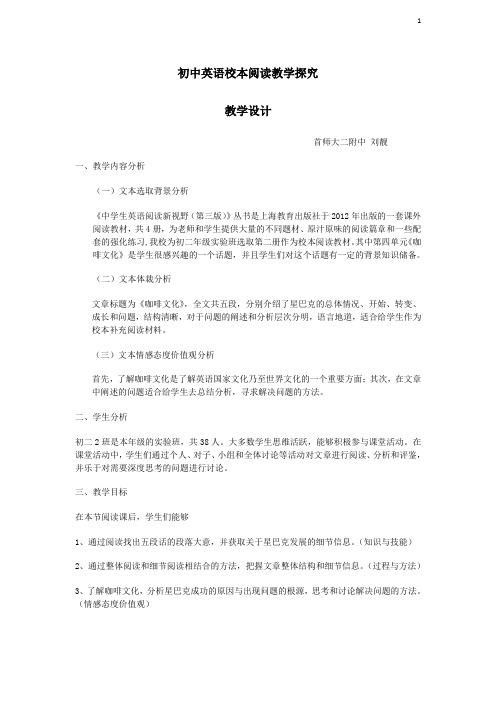
1初中英语校本阅读教学探究教学设计首师大二附中刘靓一、教学内容分析(一)文本选取背景分析《中学生英语阅读新视野(第三版)》丛书是上海教育出版社于2012年出版的一套课外阅读教材,共4册,为老师和学生提供大量的不同题材、原汁原味的阅读篇章和一些配套的强化练习,我校为初二年级实验班选取第二册作为校本阅读教材。
其中第四单元《咖啡文化》是学生很感兴趣的一个话题,并且学生们对这个话题有一定的背景知识储备。
(二)文本体裁分析文章标题为《咖啡文化》,全文共五段,分别介绍了星巴克的总体情况、开始、转变、成长和问题,结构清晰,对于问题的阐述和分析层次分明,语言地道,适合给学生作为校本补充阅读材料。
(三)文本情感态度价值观分析首先,了解咖啡文化是了解英语国家文化乃至世界文化的一个重要方面;其次,在文章中阐述的问题适合给学生去总结分析,寻求解决问题的方法。
二、学生分析初二2班是本年级的实验班,共38人。
大多数学生思维活跃,能够积极参与课堂活动。
在课堂活动中,学生们通过个人、对子、小组和全体讨论等活动对文章进行阅读、分析和评鉴,并乐于对需要深度思考的问题进行讨论。
三、教学目标在本节阅读课后,学生们能够1、通过阅读找出五段话的段落大意,并获取关于星巴克发展的细节信息。
(知识与技能)2、通过整体阅读和细节阅读相结合的方法,把握文章整体结构和细节信息。
(过程与方法)3、了解咖啡文化,分析星巴克成功的原因与出现问题的根源,思考和讨论解决问题的方法。
(情感态度价值观)四、设计思路(一)教材内容调整1、补充背景知识关于咖啡和咖啡文化,学生们是有所了解的,适当补充一些与咖啡文化相关的词汇和背景知识为阅读做好准备是完成本课阅读教与学的前提。
2、调整教材提供的学习活动教材提供的读前活动是三个问题和目标词汇的释义匹配,读中活动为回答五个阅读问题,读后活动为词汇知识的强化训练。
我做了如下的调整:读前活动为猜谜游戏和小组讨论为阅读铺垫词汇,读中活动为段落大意匹配、细节信息回答问题及填空、和文章思维导图,读后活动为深层问题的讨论。
茶文化与英语教学分析 茶文化知识
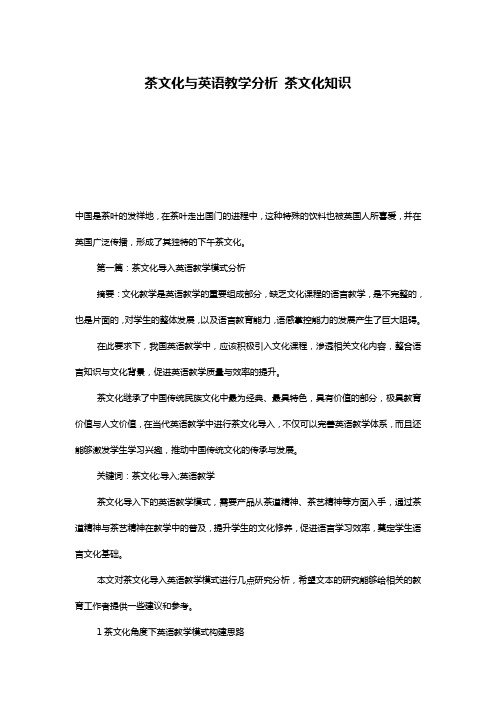
茶文化与英语教学分析茶文化知识中国是茶叶的发祥地,在茶叶走出国门的进程中,这种特殊的饮料也被英国人所喜爱,并在英国广泛传播,形成了其独特的下午茶文化。
第一篇:茶文化导入英语教学模式分析摘要:文化教学是英语教学的重要组成部分,缺乏文化课程的语言教学,是不完整的,也是片面的,对学生的整体发展,以及语言教育能力,语感掌控能力的发展产生了巨大阻碍。
在此要求下,我国英语教学中,应该积极引入文化课程,渗透相关文化内容,整合语言知识与文化背景,促进英语教学质量与效率的提升。
茶文化继承了中国传统民族文化中最为经典、最具特色,具有价值的部分,极具教育价值与人文价值,在当代英语教学中进行茶文化导入,不仅可以完善英语教学体系,而且还能够激发学生学习兴趣,推动中国传统文化的传承与发展。
关键词:茶文化;导入;英语教学茶文化导入下的英语教学模式,需要产品从茶道精神、茶艺精神等方面入手,通过茶道精神与茶艺精神在教学中的普及,提升学生的文化修养,促进语言学习效率,奠定学生语言文化基础。
本文对茶文化导入英语教学模式进行几点研究分析,希望文本的研究能够给相关的教育工作者提供一些建议和参考。
1茶文化角度下英语教学模式构建思路我国有着悠久的茶文化历史,随着人们对生活的理解和认识,使得茶文化的内容也更为丰富。
将茶文化应用到教学领域,可以确保学生学到与茶文化有关的生活知识和内容。
茶文化针对于外来文化有一定的影响,通过对二者的融合可以帮助学生良好的学习英语知识。
由于英语适用于多种场合,因此学生需要有一定的英语基础和英语口语表达能力,为以后适应各种社会场合奠定基础。
1.1英语教学模式中的茶道精神古人对饮茶有着独到的见解,邀请三五个好友一同饮茶,探讨生活、思考人生。
由茶文化而形成的茶道,更是茶文化的精髓。
不同人对茶道的独到理解形成了多种思想流派,在追求艺术的同时,也让人的内心可以远离世俗的嘈杂。
品茶的同时可以让内心趋于宁静,并能以平和的心态去思考人生。
British soak up coffee culture
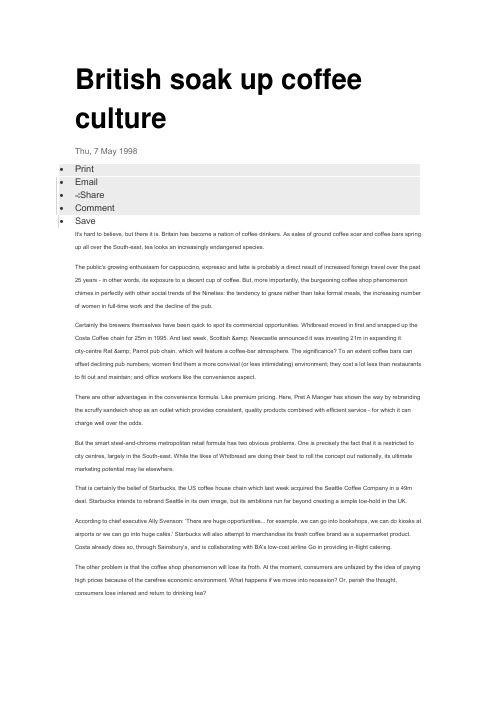
British soak up coffee cultureThu, 7 May 1998∙Email∙Share∙CommentIt's hard to believe, but there it is. Britain has become a nation of coffee drinkers. As sales of ground coffee soar and coffee bars spring up all over the South-east, tea looks an increasingly endangered species.The public's growing enthusiasm for cappuccino, expresso and latte is probably a direct result of increased foreign travel over the past25 years - in other words, its exposure to a decent cup of coffee. But, more importantly, the burgeoning coffee shop phenomenonchimes in perfectly with other social trends of the Nineties: the tendency to graze rather than take formal meals, the increasing number of women in full-time work and the decline of the pub.Certainly the brewers themselves have been quick to spot its commercial opportunities. Whitbread moved in first and snapped up the Costa Coffee chain for 25m in 1995. And last week, Scottish & Newcastle announced it was investing 21m in expanding it city-centre Rat & Parrot pub chain, which will feature a coffee-bar atmosphere. The significance? To an extent coffee bars can offset declining pub numbers; women find them a more convivial (or less intimidating) environment; they cost a lot less than restaurants to fit out and maintain; and office workers like the convenience aspect.There are other advantages in the convenience formula. Like premium pricing. Here, Pret A Manger has shown the way by rebranding the scruffy sandwich shop as an outlet which provides consistent, quality products combined with efficient service - for which it can charge well over the odds.But the smart steel-and-chrome metropolitan retail formula has two obvious problems. One is precisely the fact that it is restricted to city centres, largely in the South-east. While the likes of Whitbread are doing their best to roll the concept out nationally, its ultimate marketing potential may lie elsewhere.That is certainly the belief of Starbucks, the US coffee house chain which last week acquired the Seattle Coffee Company in a 49m deal. Starbucks intends to rebrand Seattle in its own image, but its ambitions run far beyond creating a simple toe-hold in the UK.According to chief executive Ally Svenson: 'There are huge opportunities... for example, we can go into bookshops, we can do kiosks at airports or we can go into huge cafés.' Starbucks will also attempt to merchandise its fresh coffee brand as a supermarket product.Costa already does so, through Sainsbury's, and is collaborating with BA's low-cost airline Go in providing in-flight catering.The other problem is that the coffee shop phenomenon will lose its froth. At the moment, consumers are unfazed by the idea of paying high prices because of the carefree economic environment. What happens if we move into recession? Or, perish the thought,consumers lose interest and return to drinking tea?。
(教资考试)高中英语教师资格证面试题

(教资考试)高中英语教师资格证面试题目录一、My father (1)二、British coffee culture (2)三、Global Warming (3)四、It is reported (4)五、Environmental Protection (5)六、语篇教学试讲 (6)七、A great person (7)八、讲解it形式主语 (8)九、Food production (9)十、Cultural Diversity of Australian (11)十一、讲解邮件写作 (12)十二、Wilt the Stilt-the Tower of Power! (13)十三、Special School (14)十四、Computer (15)十五、British and American English (16)十六、语音-升降调 (17)十七、Fertilizers (18)一、My father1.题目: My father2.内容:My father was a self-taught mandolin player. He was one of the best string instrument players in our town. He could not read music, but if he heard a tune a few times, he could play it. When he was younger, he was a member of a small country music band. They would play at local dances and on a few occasions would play for the local radio station. He often told us how he had auditioned and earned a position in a band that featuredPatsy Cline as their lead singer. He told the family that after he was hired he never went back. Dad was a very religious man. He stated that there was a lot of drinking and cursing the day of his audition and he did not want to be around that type of environment.3.基本要求:(1)要有板书;(2)试讲十分钟左右;(3)要有互动环节;(4)讲解语音连读。
British Clothing Culture 英国的服装文化
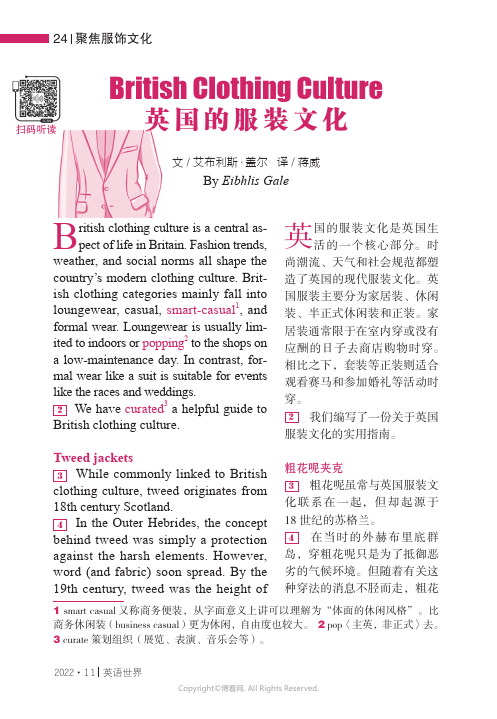
Jeans 7 Jeans are a controversial category choice within British clothing culture. Typically, you will see jeans in the casual and smart-casual clothing categories when in Britain. 8 Jeans originated in the USA back in the 19th century. The design is credited to a tailor named Davis, who sought patency from his fabric supplier, Levi Strauss. Nowadays, Levi’s remains
今,李维斯仍是服装界最大的 公司品牌之一。 9 到 20 世纪中叶,牛仔裤 已跨过大西洋,在英国服装文 化中越来越受欢迎。如今,当 你访问英国时,在英国的超市、 高级酒吧,甚至工作场所都能 看到有人穿牛仔裤。
Leggings 10 Leggings are typically regarded as somewhat of a guilty pleasure6 and worn mostly by women. While somewhat of a versatile item within British clothing culture, you can primarily expect leggings to fall under loungewear. Leggings are also popular within the sporting and fitness industry, with a matching sports bra and leggings a popular gym outfit in Britain. 11 With that said, you can dress leggings up to fit the casual category. Pairing leggings with an oversized jumper and some trendy jewelry is a popular outfit look, especially in the Autumn months. Think of a takeaway coffee street style. 12 Funnily enough, while women now favor leggings, it was military men they were designed for in 14th century Scotland.
西方咖啡文化英文介绍ppt模板

3 咖啡种类和成分
4 喝咖啡有哪些好处
5 咖啡带来的时尚
追着雨,雨赶着风,风和雨联合起来追赶着天上的乌云, 整个天地都处在雨水之中。9.一霎时,雨点连成了线, “哗”的一声,大雨就像天塌了似的铺天盖地从天空中 倾泻下来。10.狂风卷着暴雨像无数条鞭子,狠命地往 玻璃窗上抽。11.一道刺眼的闪电从天空中划过,像是 把天空划了一条大口子,紧接着“轰隆隆”一声震耳聋 的巨响在空中炸开,豆大的雨点从空中砸下来。天地之 间就像挂着一幅无比宽大的雨帘。雨点打在屋顶上、雨 棚上“叭叭”作响。风趁着雨势更加地肆虐,花草树木 在风雨中儿狂舞。不一会儿,地上水流成河。12.渐渐
西方咖啡文化英文介绍 ppt模板
盆大雨如注蒙蒙细雨密云不雨栉风沐雨牛毛细雨瓢泼大
雨铺天盖地倾盆大雨无声无息五风十雨淅淅沥沥细如牛
毛细雨绵绵细雨飘洒细雨如丝细雨如烟细雨淅沥夏雨阵
阵夏雨滋润祥风时雨阴雨连绵阴雨绵绵阴云密布雨凑云
LOGO 集雨栋风帘雨帘悬挂雨帘云栋雨零星乱雨露滋润雨霾风
障雨沐风餐雨声沙沙雨丝风片雨似急箭雨雪霏霏雨雪雰 雰翻云覆雨骤雨大作狂风骤雨久旱逢甘霖好雨知时节山
01 地,雨声变得喧哗起来。密密麻麻的雨点“哒哒哒哒”
地落在窗户上、车棚上,像一支美妙而动听的乐曲,而 夏姑娘正是这演
咖啡的起源文化
咖啡”(Coffee)(一词bai源自埃塞俄比亚的一个名叫卡法(kaffa)的小镇,在希腊语中“Kaweh”的意思是
“力量与热情”。
01 咖啡的起源文化
咖啡文化
(外文名Coffee culture)是一种文化
咖 啡 文 化
在这个"速溶"的时代,咖啡所带给我们的,不仅仅是香浓的 口味,我们要的,是一种感觉,我们会疯狂地沉浸在那种 感觉中。
Coffee Culture 咖啡文化
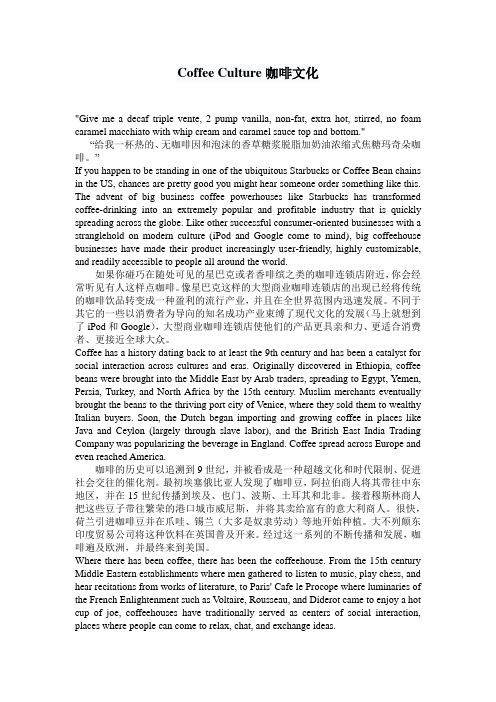
Coffee Culture 咖啡文化"Give me a decaf triple vente, 2 pump vanilla, non-fat, extra hot, stirred, no foam caramel macchiato with whip cream and caramel sauce top and bottom."“给我一杯热的、无咖啡因和泡沫的香草糖浆脱脂加奶油浓缩式焦糖玛奇朵咖啡。
”If you happen to be standing in one of the ubiquitous Starbucks or Coffee Bean chains in the US, chances are pretty good you might hear someone order something like this. The advent of big business coffee powerhouses like Starbucks has transformed coffee-drinking into an extremely popular and profitable industry that is quickly spreading across the globe. Like other successful consumer-oriented businesses with a stranglehold on modern culture (iPod and Google come to mind), big coffeehouse businesses have made their product increasingly user-friendly, highly customizable, and readily accessible to people all around the world.如果你碰巧在随处可见的星巴克或者香啡缤之类的咖啡连锁店附近,你会经常听见有人这样点咖啡。
coffee in British culture逐字稿
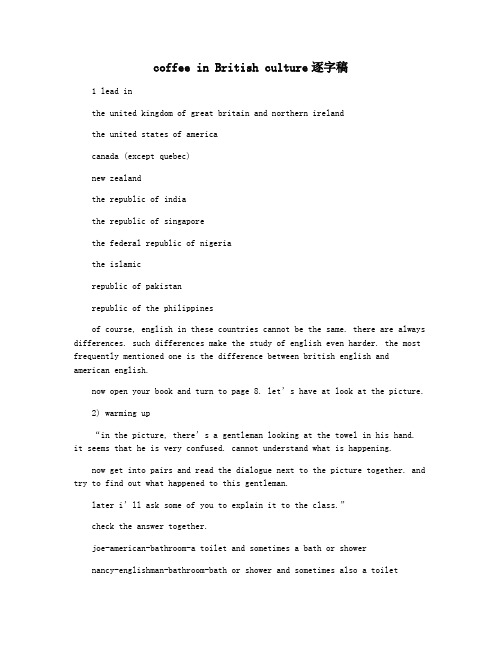
coffee in British culture逐字稿1 lead inthe united kingdom of great britain and northern irelandthe united states of americacanada (except quebec)new zealandthe republic of indiathe republic of singaporethe federal republic of nigeriathe islamicrepublic of pakistanrepublic of the philippinesof course, english in these countries cannot be the same. there are always differences. such differences make the study of english even harder. the most frequently mentioned one is the difference between british english and american english.now open your book and turn to page 8. let’s have at look at the picture.2) warming up“in the picture, there’s a gentleman looking at the towel in his hand. it seems that he is very confused. cannot understand what is happening.now get into pairs and read the dialogue next to the picture together. and try to find out what happened to this gentleman.later i’ll ask some of you to explain it to the class.”check the answer together.joe-american-bathroom-a toilet and sometimes a bath or showernancy-englishman-bathroom-bath or shower and sometimes also a toilet“besides this, i’d like to introduce some more differences betwe enbritish english and american english.first of all, a same meaning is sometimes expressed by different words. let’s look at the screen.then, some of the words have different spellings. let’s look at the chart.what’s more, the pronunciation is different for some words. let’s read these words one by one.”2 listening page 911) lead inwhat we’ve just discussed about is the differences between britishenglish and american english. what about british people and american people? do they behave in the same manner in daily life?can anyone of you tell us some differences you know?for example, englishman are said to be conservative and american peopleare more open.in order to know more about their differences, we’re going to listen to a dialogue. it’s between david and terry. david is an englishman and terry is a visitor to england from the usa. i’ll play the tape once and you finish exercise one. to tick the things that terry talks about.2) play the tape and check the answer together.4) check the answer together.3 speaking1) lead inlet’s have a quick review now. what we’ve talked about? (countries speaking english, differences between british english and american english, different manners) all of them may lead to misunderstanding. and eastern culture and western culture are even farther from each other. if you don’t understand what a foreigner is saying, what would you do. how would you ask questions?2) presentlet’s have look at the useful expressions on page 10. read through and explain one by one.3) productionget the students into groups of 4 or 5. pick a member from each group and give him or her a piece of paper wi th a sentence on it, like “tina says sheis a cat/dog person” as well as some necessary explanation of the sentence. ask this student to read the sentence to his group members. and answer the other members’ questions.push the students to use the expre ssions we’ve just learnt so as to comprehend the new knowledge in the sentence.find some groups to explain the meaning of the sentence to the whole class.4 homework1) preview reading and think about one question: when do we use englishout of school.2) page 91 talking do the match3) page 92, practicing (vocabulary)4)period two1 check homework1) page 91check the answer together.ask the students to make mini dialogues. only start a conversation and end it. they don’t need to add any content into the dialogue. only include greeting and goodbye in their small talks.2) page 92 vocabulary exercise 2check the answer together.2 pre-reading1) how many languages do you speak?include: listening to pop songs, accessing software and web sites, chat rooms, reading packages of products.3 reading1) introduction: this text is about the development of english over the past fifty years.let me show you some information about english as a language first.you’ve been learning english for 5 or 6 years, but you may not know how universal the usage of english is.2) skimminglook at the screen. these three sentences are the main idea of the three paragraphs respectively. read through the text quickly and tell me which paragraph each of them belongs to.or: find the key sentences of each paragraph.para 2: the number of people who learn english as a foreign language is more than million.para 3: english is the working language of most international organizations, trade and touris3) look for details: read the text again and fill in the chart.4) language pointsmajoritythere are more than 42 countries where the majority of the people speak english.�cthe majority of children in our class have brown eyes; only three have blue eyes.�cthe nation wants peace; only a minority want(s) the war to continue.major (adj./n. /v.)--these are the major causes of traffic ja--my major is english. = i am majoring in english.in total, for more than million people english is their mother tongue. an equal number of people learn english as a second language.�cit is equal to me whether he comes or not. (the same in size, value, amount etc as something else)�che is equal to this task; he is equal to doing this task. (have the ability to deal with a problem)�ceight times eight equals sixty-four.-- equality of opportunity is an equal opportunity to prove unequal talents.howeverhowever, the number of people who learn english as a foreign language is more than million.�chowever sly a fox may be, it is no match for a good hunter.�cthe book is expensive; however, it's worth it.except for (apart from)china students learn english at school as a foreign language, except for those in hong kong, where many people speak english as a first or second language.--tom does everything around the house except cook. (apart from doing something)�cno one except me knew it. (not including)�cbesides milk and cheese, we need vegetables. (in addition to)i don’t want to go to the cinema; besides i’m feeling too tired. 我不敢回去看看电影,再说我也太辛苦了。
英语演讲(英国茶文化culture)
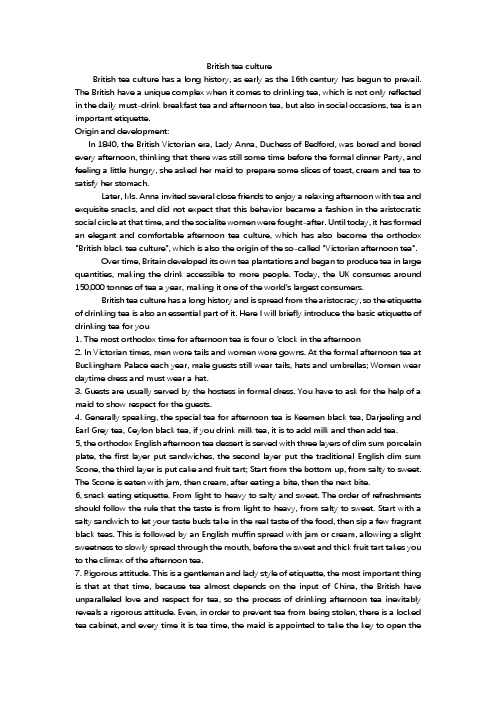
British tea cultureBritish tea culture has a long history, as early as the 16th century has begun to prevail. The British have a unique complex when it comes to drinking tea, which is not only reflected in the daily must-drink breakfast tea and afternoon tea, but also in social occasions, tea is an important etiquette.Origin and development:In 1840, the British Victorian era, Lady Anna, Duchess of Bedford, was bored and bored every afternoon, thinking that there was still some time before the formal dinner Party, and feeling a little hungry, she asked her maid to prepare some slices of toast, cream and tea to satisfy her stomach.Later, Ms. Anna invited several close friends to enjoy a relaxing afternoon with tea and exquisite snacks, and did not expect that this behavior became a fashion in the aristocratic social circle at that time, and the socialite women were fought-after. Until today, it has formed an elegant and comfortable afternoon tea culture, which has also become the orthodox "British black tea culture", which is also the origin of the so-called "Victorian afternoon tea".Over time, Britain developed its own tea plantations and began to produce tea in large quantities, making the drink accessible to more people. Today, the UK consumes around 150,000 tonnes of tea a year, making it one of the world's largest consumers.British tea culture has a long history and is spread from the aristocracy, so the etiquette of drinking tea is also an essential part of it. Here I will briefly introduce the basic etiquette of drinking tea for you1. The most orthodox time for afternoon tea is four o 'clock in the afternoon2. In Victorian times, men wore tails and women wore gowns. At the formal afternoon tea at Buckingham Palace each year, male guests still wear tails, hats and umbrellas; Women wear daytime dress and must wear a hat.3. Guests are usually served by the hostess in formal dress. You have to ask for the help of a maid to show respect for the guests.4. Generally speaking, the special tea for afternoon tea is Keemen black tea, Darjeeling and Earl Grey tea, Ceylon black tea, if you drink milk tea, it is to add milk and then add tea.5, the orthodox English afternoon tea dessert is served with three layers of dim sum porcelain plate, the first layer put sandwiches, the second layer put the traditional English dim sum Scone, the third layer is put cake and fruit tart; Start from the bottom up, from salty to sweet. The Scone is eaten with jam, then cream, after eating a bite, then the next bite.6, snack eating etiquette. From light to heavy to salty and sweet. The order of refreshments should follow the rule that the taste is from light to heavy, from salty to sweet. Start with a salty sandwich to let your taste buds take in the real taste of the food, then sip a few fragrant black teas. This is followed by an English muffin spread with jam or cream, allowing a slight sweetness to slowly spread through the mouth, before the sweet and thick fruit tart takes you to the climax of the afternoon tea.7. Rigorous attitude. This is a gentleman and lady style of etiquette, the most important thing is that at that time, because tea almost depends on the input of China, the British have unparalleled love and respect for tea, so the process of drinking afternoon tea inevitably reveals a rigorous attitude. Even, in order to prevent tea from being stolen, there is a lockedcabinet and take tea.8. Appreciate the exquisite tea ware.What is the magic of the traditional English afternoon tea that so captivates the British appetite? If you have never tasted the English afternoon tea, when the waiter will be three layers of snacks on the table, you can immediately experience the exquisite, aristocratic atmosphere of English afternoon tea. After a layer of taste, you can better understand what kind of delicious people can not stop mouth.Step 1: Enjoy a delicious snack.Usually the first layer of the three-story tower is filled with salty sandwiches, such as ham, cheese, etc., but these sandwiches are not made by the dim sum chef, but by another sandwich maker. In general, the second layer usually puts scones, which is the essential English afternoon tea, with cream and jam, which is prepared by the chef, and the third layer of desserts is not fixed, but the chef chooses to put suitable snacks, usually cakes and fruit tartsPart Two: Appreciate the exquisite tea ware.Victoria afternoon tea is a comprehensive art, simple but not shabby, gorgeous but not vulgar... While time and food are the most important elements of a proper English afternoon tea, without good tea, China, music, and even a good mood, afternoon tea is not enough.Part Three: Tea tasting.Afternoon tea, "tea" is the absolute protagonist. Special afternoon tea is divided into Darjeeling and Earl Grey tea, Ceylon tea and other types. Generally, tea is brewed directly, and then filtered through the tea glass to pour the tea residue into the cup. Transparent glass teapot, when the hot water poured down, you can see the tea tips slowly opening in the water. The most beautiful thing is the rose tea, watching the small rose petals dancing in the water, the mood also follows the dance. The combination of black tea and milk seems to be an elegant aristocrat meeting a celebrity gentleman, whether it is a sip or a hearty drink, in the cold winter, the hot milk tea is undoubtedly a warm secret formula, instantly sliding from the tip of the tongue to the wall of the stomach, after a long time, the mouth still leaves a light sweet, let people taste, milk tea can also be paired with afternoon snacks. Whether it is a rich cheesecake, sweet and waxy chocolate muffin, or casual thick toast, simple pineapple bun, also in the west, milk tea can be happy to accompany.Tea is used more frequently in English literature, where it tells stories and scenes of characters. Under the influence of British afternoon tea culture, one of the characteristics of British writers is their admiration for Chinese tea. The great 18th century English writer Samuel Johnson said, "Tea is for the evening, tea is for the evening, tea is for the morning." The literary club he founded was popular when drinking tea with friends. Playwright Pinheiro appreciates the spiritual civilization of tea tasting: "Where there is tea, there is hope." Others, such as the poet Wordsworth and the writer Dickens, spoke highly of tea culture. Many of the main characters in Pride and Prejudice have Chinese tea parties after dinner. When the clock strikes four, everything in the world stops for tea, and at this time, even if you have something very important, you must wait until the English have finished their afternoon tea. Both Britain and China are big tea drinking countries with their own unique tea culture, representing differentin history, have used imported products from China to create their own unique and beautiful way of drinking tea, famous for its rich connotation and elegant form of "English afternoon tea".。
咖啡文化英语作文300字
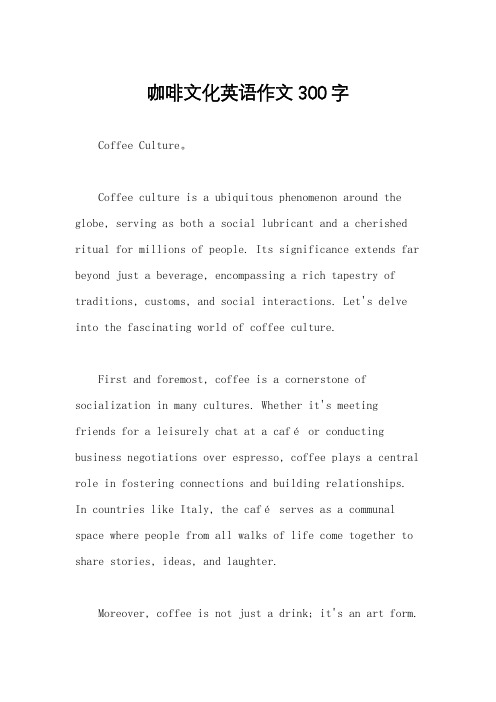
咖啡文化英语作文300字Coffee Culture。
Coffee culture is a ubiquitous phenomenon around the globe, serving as both a social lubricant and a cherished ritual for millions of people. Its significance extends far beyond just a beverage, encompassing a rich tapestry of traditions, customs, and social interactions. Let's delve into the fascinating world of coffee culture.First and foremost, coffee is a cornerstone of socialization in many cultures. Whether it's meetingfriends for a leisurely chat at a café or conducting business negotiations over espresso, coffee plays a central role in fostering connections and building relationships. In countries like Italy, the café serves as a communal space where people from all walks of life come together to share stories, ideas, and laughter.Moreover, coffee is not just a drink; it's an art form.From the meticulous process of growing and harvesting the beans to the precise methods of roasting and brewing, every step in the journey from bean to cup is infused with craftsmanship and expertise. Baristas, often likened to artisans, masterfully craft intricate designs atop lattes and cappuccinos, turning each cup into a work of art.Furthermore, coffee culture is steeped in tradition and ceremony. In Ethiopia, the birthplace of coffee, the brewing process is elevated to a sacred ritual known as the coffee ceremony. Here, coffee beans are roasted, ground, and brewed in front of guests, symbolizing hospitality and community. Similarly, in Japan, the art of the tea ceremony has been adapted to include coffee, blending ancient customs with modern tastes.Additionally, coffee culture is constantly evolving and adapting to new trends and technologies. The rise of specialty coffee shops and third-wave coffee movements has sparked a renewed appreciation for the complexities of coffee flavors and aromas. Consumers are now more discerning than ever, seeking out single-origin beans andsustainable brewing methods that prioritize quality and ethical sourcing.In conclusion, coffee culture transcends geographical boundaries and language barriers, uniting people around the world in a shared love for this beloved beverage. Whether it's sipping espresso on the streets of Rome or enjoying a pour-over in a trendy café in Brooklyn, the rituals and traditions of coffee enrich our lives and remind us of the power of connection and community. So, next time you take a sip of your favorite brew, take a moment to savor not just the flavor, but the rich tapestry of culture and history that accompanies it.。
Coffee-Culture咖啡文化讲解学习
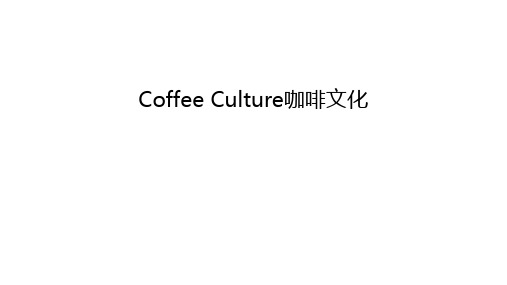
1| Coffee Bean
EXHIBITION
TEXT HERE
EXHIBITION
TEXT HERE
北苏门答腊一级曼特 宁 North Sumantra Mandheling Grade 1
肯尼亚咖啡生豆 Kenya AA green bean
埃塞尔比亚 耶加 雪啡咖啡生豆 Ethiopia Washed Yirgacheffe
【Cappuccino】卡布奇诺
由黑色的浓缩咖啡 Espresso加上白色的牛奶及 奶泡相拥而成。原名是属基督教於西元1528 年建立的芳济教会一个修道派别的名称。该 派教士身穿的长袍带有盖头风帽。就如同当 前盛行的咖啡加上像帽子一样的牛奶泡泡。 寓意:我爱你
【Macchiato】焦糖玛琪朵
意大利文,Macchiato是『烙印』的意思。焦糖玛琪朵是加了 焦糖的Macchiato代表『甜蜜的印记』,你烙印在我心中。
埃塞尔比亚 耶加雪啡咖啡生豆
Ethiopia Washed Yirgacheffe
耶加雪啡是东非精品咖啡(specialty coffee) 的代表,有着很特别、不寻常的柑橘果香及花 香,使得耶加雪啡成为世界上最有特色的咖啡 之一,比较少见及昂贵,出产于埃塞尔比亚西 达摩省(sidamo)海拔4000英尺高原地带, 在一个比较高且狭小的地区。耶加雪啡为一般 摩卡难以企及的高品质,同时也是非洲水洗咖 啡的优秀代表。
肯尼亚咖啡生豆 Kenya AA green bean
咖啡在19世纪进入肯尼亚,当时埃塞俄比亚的咖啡 饮品经由南也门进口到肯尼亚。但直到20世纪初, 波旁咖啡树才由圣奥斯汀使团(St. Austin Mission) 引入。肯尼亚咖啡大多生长在海拔1500~2100米的 地方,一年中收获两次。为确保只有成熟的浆果被 采摘,人们必须在林间巡回检查,来回大约7 次。 肯尼亚咖啡由小耕农种植,他们收获咖啡后,先把 鲜咖啡豆送到合作清洗站,由清洗站将洗过晒干的 咖啡以“羊皮纸咖啡豆”(即外覆内果皮的咖啡豆) 的状态送到合作社(“羊皮纸咖啡豆”是咖啡豆去皮 前的最后状态)。所有的咖啡都有收集在一起,种植 者根据其实际的质量按平均价格要价。这种买卖方 法总体上运行良好, 对种植者及消费者都公平。
咖啡礼仪文化英语作文
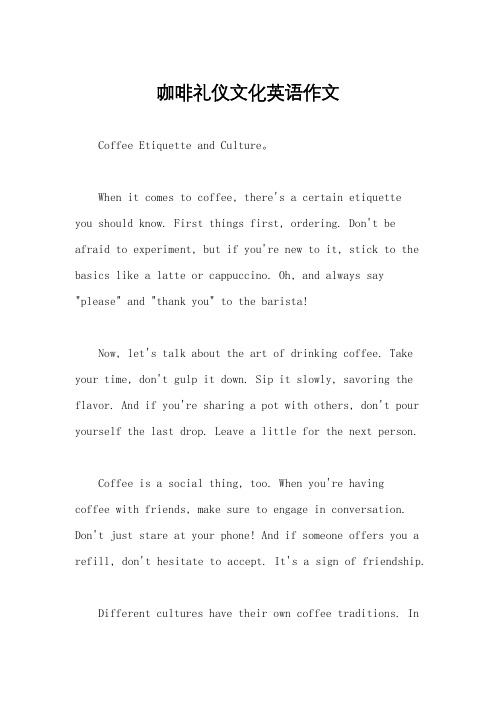
咖啡礼仪文化英语作文Coffee Etiquette and Culture。
When it comes to coffee, there's a certain etiquetteyou should know. First things first, ordering. Don't be afraid to experiment, but if you're new to it, stick to the basics like a latte or cappuccino. Oh, and always say "please" and "thank you" to the barista!Now, let's talk about the art of drinking coffee. Take your time, don't gulp it down. Sip it slowly, savoring the flavor. And if you're sharing a pot with others, don't pour yourself the last drop. Leave a little for the next person.Coffee is a social thing, too. When you're havingcoffee with friends, make sure to engage in conversation. Don't just stare at your phone! And if someone offers you a refill, don't hesitate to accept. It's a sign of friendship.Different cultures have their own coffee traditions. Insome places, coffee is a morning ritual, while others prefer an afternoon pick-me-up. There's even a Turkish tradition of making coffee in a special pot called a cezve. So, when you travel, be sure to try the local coffeeculture!。
聊咖啡的文化英语对话作文
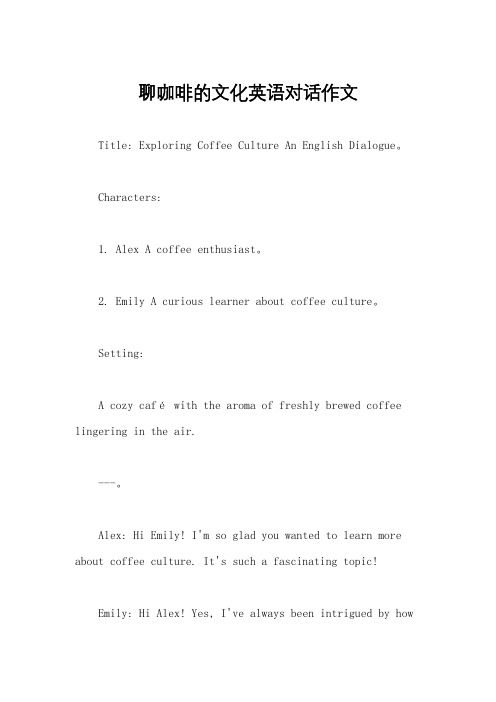
聊咖啡的文化英语对话作文Title: Exploring Coffee Culture An English Dialogue。
Characters:1. Alex A coffee enthusiast。
2. Emily A curious learner about coffee culture。
Setting:A cozy café with the aroma of freshly brewed coffee lingering in the air.---。
Alex: Hi Emily! I'm so glad you wanted to learn more about coffee culture. It's such a fascinating topic!Emily: Hi Alex! Yes, I've always been intrigued by howcoffee is more than just a beverage in many places. It seems like it has its own culture.Alex: Absolutely! Coffee culture is rich and diverse, varying from country to country and even region to region within countries. For instance, in Italy, coffee is almosta ritualistic part of daily life.Emily: That's interesting. How is coffee culturedifferent there?Alex: Well, in Italy, people often drink espresso,which is a concentrated form of coffee served in small cups. It's common for Itali ans to enjoy their espresso at a café counter while standing and chatting with friends or colleagues. It's all about the social aspect and quick enjoyment of the coffee.Emily: Ah, I see. So, it's not just about drinkingcoffee but also about the experience and social interaction.Alex: Exactly! And it's not just Italy; coffee culturevaries across Europe. In places like France, coffee is often enjoyed leisurely at cafés, accompanied by pastries or desserts.Emily: What about in other parts of the world?Alex: Well, in the Middle East, like in Turkey, coffee is often brewed in a special pot called a cezve, and it's much stronger than what you might find in European countries. It's often served with a bit of spice like cardamom and enjoyed slowly, often with family or during important social gatherings.Emily: That sounds like a unique experience. And what about coffee culture in other regions?Alex: In places like Ethiopia, coffee ceremonies are an integral part of their culture. It's a ceremonial way of preparing and serving coffee, often involving roasting the beans right in front of guests and serving it with great care and respect.Emily: Wow, I had no idea coffee could be so deeply ingrained in cultural practices.Alex: Absolutely! Coffee is not just a beverage; it's a symbol of hospitality, socializing, and even spiritualityin some cultures.Emily: This is all so fascinating. I never realized there was so much to learn about coffee beyond justdrinking it.Alex: I'm glad I could share some insights with you. Coffee culture is truly diverse and deserves to be explored and appreciated.Emily: Definitely! I think I'll start paying more attention to the coffee I drink and the culture surrounding it from now on.Alex: That's great to hear! And if you ever want to dive deeper into any aspect of coffee culture, feel free to ask. I'm always here to chat about it.Emily: Thanks, Alex! I'll definitely take you up on that offer.。
英伦红茶文化在英语语言学教学中应用研究
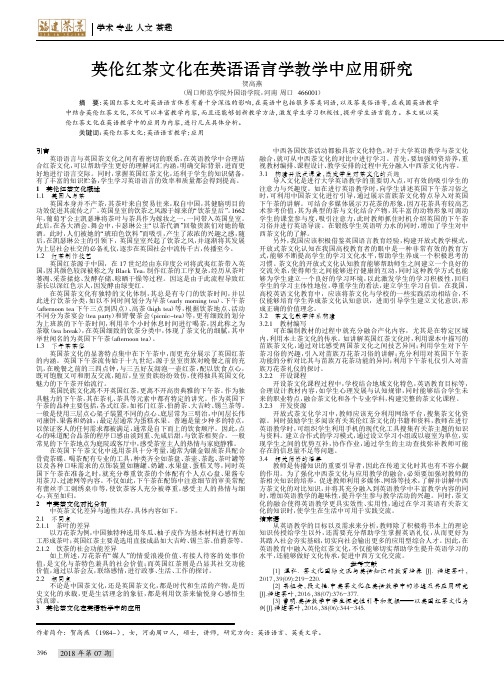
2018年第07期学术专业人文茶趣作者简介:贺高燕(1984-),女,河南周口人,硕士,讲师,研究方向:英语语言、英美文学。
引言英语语言与英国茶文化之间有着密切的联系,在英语教学中合理结合红茶文化,可以帮助学生更好的理解词汇内涵,明确交际背景,进而更好地进行语言交际。
同时,掌握英国红茶文化,还利于学生的知识储备,有了丰富的知识贮备,学生学习英语语言的效率和质量都会得到提高。
1英伦红茶文化概述1.1英国人与茶英国本身并不产茶,其茶叶来自贸易往来,取自中国,其健脑明目的功效促进其流传之广。
英国皇室的饮茶之风源于嫁来的“饮茶皇后”。
1662年,葡萄牙公主凯瑟琳将茶叶与茶具作为嫁妆之一,一同带入英国皇室。
此后,在各大酒会、舞会中,卡瑟琳公主“以茶代酒”回敬贵族们对她的敬酒。
此时,人们被她的“琥珀色饮料”而吸引,产生了浓浓的兴趣之感,随后,在凯瑟琳公主的引领下,英国皇室兴起了饮茶之风,并逐渐将其发展为上层社会社交的必备礼仪,逐步在英国社会中流传千古,传播至今。
1.2红茶制作技艺英国红茶源于中国,在17世纪经由东印度公司将武夷红茶带入英国,因其颜色较深被称之为Black Tea 。
制作红茶的工序复杂,经历从茶叶萎凋、采茶揉捻、发酵存储、晾晒干燥等过程。
因这是由于此流程导致红茶长以深红色示人,因发酵由绿变红。
在英国茶文化有独特的文化体制,其总是有专门的饮茶时间,并以此进行饮茶分类,如以不同时间划分为早茶(early morning tea )、下午茶(afternoon tea 下午三点到四点)、高茶(high tea )等,根据饮茶地点、活动不同分为茶宴会(tea party )和野餐茶会(picnic-tea )等,更有细致的划分为上班族的下午茶时间,利用半个小时休息时间进行喝茶,因此称之为茶歇(tea break ),在英国细致的饮茶分类中,体现了茶文化的细腻,其中举世闻名的为英国下午茶(afternoon tea )。
高中英语-British coffee culture试讲
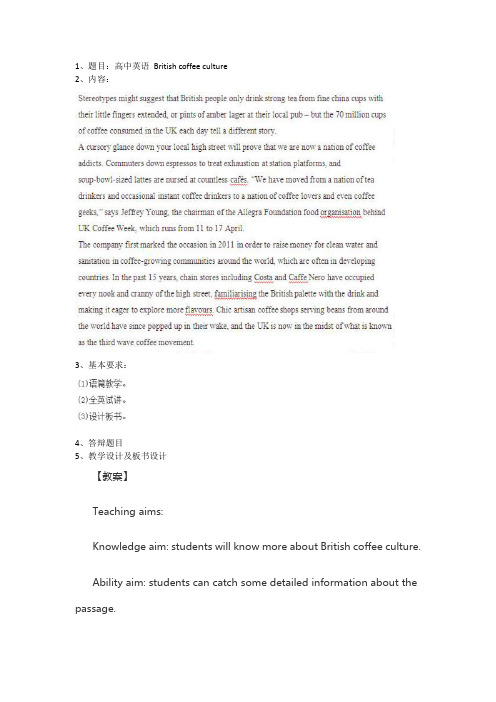
1、题目:高中英语British coffee culture2、内容:3、基本要求:4、答辩题目5、教学设计及板书设计【教案】Teaching aims:Knowledge aim: students will know more about British coffee culture.Ability aim: students can catch some detailed information about the passage.Emotional aim: students will appreciate different culture.Key and difficult point:Students will get the general idea of this passage.Students can express their ideas about the topic.Teaching procedure:Step 1: Warming-upGreet the students.Have a free talk with them and ask them if they drink coffee.Step 2: Pre-readingPlay them a short video to introduce British tea culture, and fill them in with the information that Britain has a long history for tea culture to give them some background information for the passage understanding.Step 3: While-reading1st reading: give them 2 minutes to read the passage quickly to get the general idea of this passage and invite some students to share their answers.2nd reading: leave the question to them--what is the stereotype and truth about British people? And give them 5 minutes to read the passagecarefully to find the answers. After 5 minutes, invite some students to share their ideas. And then divide them into groups of 4 to find the evidence from the text to support their ideas.Step4: Post-readingActivity 1: invite two students to retell the passage according the clues on the blackboard.Activity 2: divide them into groups of 3 to talk about China food culture.Step5: Summary and homeworkInvite a student to make a summary then leave them the homework-search online for the development of coffee culture in China.Blackboard design:略。
english-tea-and-coffee-culture(英国茶和咖啡文化)讲课稿
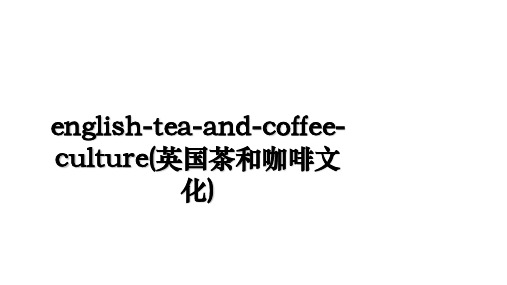
结束
通常地,一般地 热巧克力 软饮料 也,和...一样 葡萄酒 咖啡屋 股票交易 商人 银行家 做生意
1. apart from 2. as a源自result 3. in groups
除..之外 结果,所以
以小组形式
Questions
1. What do we often think of when we think of western tea culture today?
英国文化 共享 好茶 西方的 一位英国的公爵夫人 提出,介绍,引进 下午茶 世纪,百年 饥饿的 解决
1. come up with
想出来
2. invite sb. to do sth. 邀请某人做某事
3. include
包括
4. sandwich
三明治
5. serve
提供,招待,服务,端上来
6. wash down
2. who do people believe first introduced the afternoon tea?
3. Why did the Dutchess invite friends to come for tea in the afternoon?
4. How did they make the afternoon meal important? 5. What does "Will you come for coffee" mean? 6. Apart from drinking coffee, what did people do in the
在...起作用
7. the social life
社会生活
8. wealthy
- 1、下载文档前请自行甄别文档内容的完整性,平台不提供额外的编辑、内容补充、找答案等附加服务。
- 2、"仅部分预览"的文档,不可在线预览部分如存在完整性等问题,可反馈申请退款(可完整预览的文档不适用该条件!)。
- 3、如文档侵犯您的权益,请联系客服反馈,我们会尽快为您处理(人工客服工作时间:9:00-18:30)。
二、考题解析
【教案】
Teaching aims:
Knowledge aim: students will know more about British coffee culture. Ability aim: students can catch some detailed information about the passage. Emotional aim: students will appreciate different culture.
Key and difficult point:
Students will get the general idea of this passage.
Students can express their ideas about the topic.
Teaching procedure:
Step 1: Warming-up
Greet the students.
Have a free talk with them and ask them if they drink coffee.
Step 2: Pre-reading
Play them a short video to introduce British tea culture, and fill them in with the information that Britain has a long history for tea culture to give them some background information for the passage understanding.
Step 3: While-reading
1st reading: give them 2 minutes to read the passage quickly to get the general idea of this passage and invite some students to share their answers.
2nd reading: leave the question to them--what is the stereotype and truth about British people? And give them 5 minutes to read the passage carefully to find the answers. After 5 minutes, invite some students to share their ideas. And then divide them into groups of 4 to find the evidence from the text to support their ideas.
Step4: Post-reading
Activity 1: invite two students to retell the passage according the clues on the blackboard.
Activity 2: divide them into groups of 3 to talk about China food culture.
Step5: Summary and homework
Invite a student to make a summary then leave them the homework-search online for the development of coffee culture in China.
Blackboard design:。
